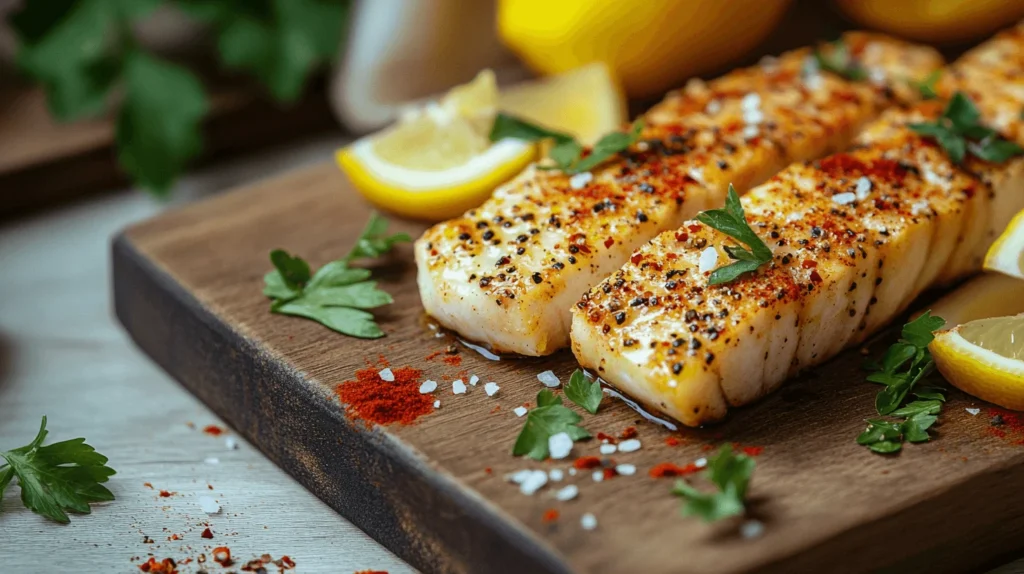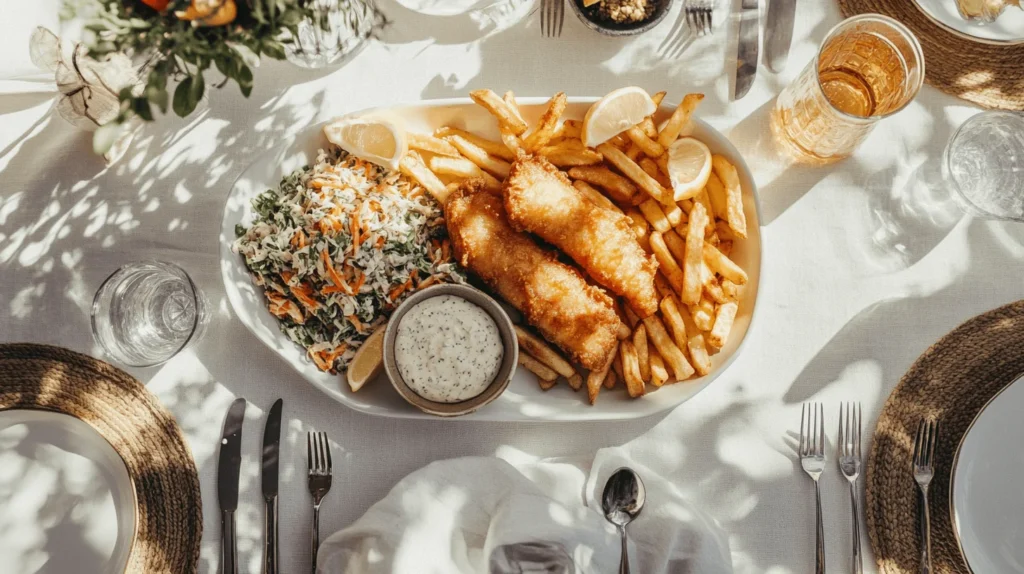Fish and chips is a beloved classic in many cultures, especially in the UK. However, those on a lectin-free diet might find the traditional recipe doesn’t align with their dietary needs. Lectins, naturally occurring proteins found in many foods, can cause digestive issues and inflammation in some people. If you’re looking for a lectin-free fish and chips recipe, you’re in the right place. This article will guide you through making this dish with ingredients that are both healthy and delicious while steering clear of lectins.
In this guide, we’ll discuss what lectins are, why they may not be suitable for everyone, and how to make a tasty, lectin-free version of this iconic meal. Whether you’re following a lectin-free diet for health reasons or simply want to enjoy a lighter take on a classic dish, you’ll find everything you need to know.
What Are Lectins?
Lectins are a type of protein found in many plant-based foods like beans, grains, and some vegetables. While lectins play a protective role in plants, they can also interfere with nutrient absorption and potentially cause digestive discomfort in some people. Ingesting high amounts of lectins, especially when foods are not properly prepared (like soaking beans or cooking grains), can lead to digestive distress and inflammation.
For those on a lectin-free diet, avoiding foods that contain high levels of lectins becomes essential. Common culprits include wheat, tomatoes, and legumes. Since fish and chips typically use these ingredients, it’s important to find alternatives that still deliver the flavor and texture of this beloved dish without the negative effects of lectins.
Why Consider a Lectin-Free Diet?
A lectin-free diet is often considered by individuals who experience discomfort after consuming certain foods, such as bloating, gas, or digestive issues. Studies suggest that lectins can interfere with gut health by binding to carbohydrates in the digestive system, which can lead to inflammation or even impair nutrient absorption.
Choosing a lectin-free lifestyle can support overall digestive health, boost energy levels, and help those with autoimmune conditions manage symptoms. By replacing lectin-rich foods with suitable alternatives, many people experience improvements in their digestion and overall well-being.Discover the healthiest fish for fish and chips that work seamlessly in a lectin-free diet.
Health Benefits of a Lectin-Free Diet
Adopting a lectin-free diet can offer a range of health benefits. Not only does it reduce the risk of digestive upset, but it can also help manage certain autoimmune conditions. For instance, individuals with irritable bowel syndrome (IBS), rheumatoid arthritis, or fibromyalgia may find relief by cutting back on foods rich in lectins.
Additionally, removing lectin-heavy foods from your diet can lead to more energy, better sleep, and improved skin health. A lectin-free diet often encourages whole, unprocessed foods like lean meats, fish, vegetables, and fruits that are naturally free of lectins. This focus on whole foods contributes to overall health and may also promote weight loss and improve cardiovascular health.
By substituting lectin-rich ingredients in your recipes, you can prepare lectin-free fish and chips without sacrificing flavor or texture.
Understanding the Traditional Fish and Chips Recipe
Before diving into our lectin-free fish and chips recipe, it’s important to understand the traditional version of the dish. Classic fish and chips typically consist of battered fish, fried to a golden crisp, paired with thick-cut fries. The dish is often served with condiments like malt vinegar, tartar sauce, or peas. While delicious, the traditional recipe includes a few ingredients that are high in lectins.
The Classic Ingredients in Fish and Chips
Traditional fish and chips include the following ingredients:
- Fish: Usually white fish like cod or haddock.
- Flour: Used to create the batter.
- Potatoes: Cut into thick chips and fried.
- Oil: Used for frying the fish and chips.
- Seasoning: Salt, pepper, and sometimes additional herbs or spices.
While the ingredients themselves are simple, the flour used in the batter and the type of oil chosen can pose issues for those on a lectin-free diet. Many traditional recipes rely on wheat flour and high-lectin oils, which are not suitable for everyone.
Why Traditional Fish and Chips May Not Be Lectin-Free
The key challenge with traditional fish and chips lies in the batter and the oil. Most recipes use wheat flour for the batter, which contains lectins. Additionally, deep frying in oils that are high in omega-6 fatty acids, such as vegetable oil or sunflower oil, can increase inflammation in the body.
To make the dish suitable for a lectin-free diet, we need to substitute these ingredients with alternatives that provide the same delicious results without the downsides of lectins. By making a few simple swaps, you can enjoy the comfort of fish and chips while keeping it friendly for your digestive system.
Key Substitutions for a Lectin Free Fish and Chips Recipe
Now that we understand the traditional recipe, it’s time to make the necessary substitutions to create a lectin-free fish and chips recipe. These changes will ensure the dish remains delicious and safe for those avoiding lectins.
Lectin-Free Fish Options
When choosing fish for your lectin-free fish and chips, it’s important to stick with naturally lectin-free options. Fish is inherently free from lectins, making it an excellent protein source for your dish. However, the type of fish you choose can affect the flavor and texture of the final dish.
Popular choices include cod, haddock, pollock, and halibut. Each offers a mild flavor and firm texture that work well for frying. For advice on the best types, check out our post on the least fishy fish for fish and chips.
Choosing the Best Fish for Your Recipe
The best fish for lectin-free fish and chips are those that are mild-flavored and firm enough to hold up to frying. Popular choices include:
- Cod: A classic choice with a light, flaky texture.
- Haddock: Another traditional fish with a slightly sweeter taste.
- Pollock: Mild and tender, making it perfect for battering and frying.
- Halibut: A thicker fish with a meaty texture, ideal for crispy batter.
Opt for fresh or frozen fish, depending on availability, ensuring that it’s sustainably sourced and free from any additives or preservatives.
Lectin-Free Flour Alternatives for the Batter
In traditional fish and chips, wheat flour is used to create the crispy batter. However, for those on a lectin-free diet, wheat flour is a no-go. Instead, you’ll need to replace it with flour alternatives that are naturally free from lectins.
If you’re curious about other lectin-free alternatives, our article on are plantain chips lectin-free? offers insightful substitutions.

Best Flour Substitutes for Fish Batter
There are several excellent lectin-free flour options you can use to make the batter:
- Almond Flour: A great gluten-free option that offers a slightly nutty flavor.
- Coconut Flour: A low-carb alternative that creates a light, crisp batter.
- Chickpea Flour: High in protein and provides a hearty texture to the batter.
- Rice Flour: Offers a delicate texture that crisps up nicely when fried.
Each of these flours can be used in combination or on their own, depending on your preference and dietary needs.
Alternative Oils for Frying
Traditional fish and chips are often fried in oils that are high in omega-6 fatty acids, such as vegetable oil or sunflower oil. For a lectin-free fish and chips recipe, it’s important to choose oils that are more stable and healthier for frying.
Healthier Oil Options for Frying Fish
Consider these healthier oil alternatives:
- Coconut Oil: Rich in healthy fats and perfect for high-temperature frying.
- Avocado Oil: A stable, high-heat oil that is rich in monounsaturated fats.
- Olive Oil: Great for lighter frying or pan-frying.
These oils offer healthier fats and are less inflammatory compared to vegetable oils.
Step-by-Step Instructions for Making Lectin Free Fish and Chips
Creating the perfect lectin-free fish and chips recipe doesn’t have to be difficult. With the right substitutions, you can make a dish that rivals the traditional version. Here’s a step-by-step guide to preparing this delicious, lectin-free meal.
Preparing the Fish for the Batter
Start by preparing your fish fillets. If using frozen fish, make sure it is fully thawed and pat the fillets dry with paper towels. Drying the fish helps the batter adhere better. Cut the fish into manageable pieces, making sure they are of similar size for even cooking.

Next, season the fish with salt, pepper, and any herbs you like (such as garlic powder or paprika) to enhance the flavor.
Making the Perfect Batter
To make the batter, combine your chosen lectin-free flour with cold sparkling water. The sparkling water creates a light, airy batter that crisps up perfectly when fried. Season the batter with salt, pepper, and a pinch of baking powder to help it puff up.
Dredge each piece of fish in the batter, ensuring it’s fully coated. Let any excess batter drip off before frying.
How to Fry the Fish and Chips to Perfection
Heat your chosen oil in a deep fryer or large skillet to around 350°F (175°C). Fry the fish pieces for 4-5 minutes, or until golden brown and crispy. Avoid overcrowding the pan, as this can cause the temperature of the oil to drop and result in soggy fish.
For the chips, cut the potatoes into thick wedges or traditional chip shapes, then fry them in batches until crispy and golden. Drain the fish and chips on paper towels to remove excess oil.
Tips for Serving and Pairing Your Lectin Free Fish and Chips
While fish and chips are delicious on their own, serving them with the right sides and sauces can elevate the meal.
Best Sides and Sauces to Complement the Dish
Here are some great sides and sauces to pair with your lectin-free fish and chips recipe:
- Coleslaw: A crunchy, tangy side dish that complements the fish perfectly.
- Mushy Peas: A traditional side that is simple and satisfying.
- Lemon Wedges: A squeeze of fresh lemon adds brightness to the dish.
For sauces, consider:
- Homemade Tartar Sauce: Made with lectin-free mayo, mustard, and pickles.
- Ketchup: A classic, though opt for a sugar-free version to keep it healthier.
- Garlic Aioli: A creamy, flavorful dip for the fish.

How to Serve Lectin Free Fish and Chips for a Complete Meal
For a complete meal, serve your fish and chips with a side of steamed vegetables or a light salad. This adds nutritional value to the dish while balancing the flavors. A lectin-free fish and chips recipe can also be paired with a glass of sparkling water or a light, dry white wine for an elegant touch.
Nutritional Value of Lectin Free Fish and Chips
Making the switch to a lectin-free version of fish and chips doesn’t mean sacrificing nutritional value. By using healthier ingredients, this dish can be both satisfying and nutrient-rich.
Health Benefits of Lectin-Free Fish and Chips
A lectin-free fish and chips recipe provides a good source of protein from the fish, while the use of alternative flours and oils offers healthier fats. Additionally, using fresh vegetables as sides increases the fiber content of the meal.
Lower Carb and Gluten-Free Option
By using lectin-free flours like almond or coconut flour, this recipe becomes gluten-free and lower in carbs compared to traditional fish and chips. This makes it a suitable option for those on a low-carb or gluten-free diet, such as individuals following keto or paleo diets.
Comparison to Traditional Fish and Chips
When compared to traditional fish and chips, the lectin-free version is less likely to cause digestive issues and is a healthier alternative in terms of fat and carbohydrate content. By replacing wheat flour and high-lectin oils, you reduce inflammation and digestive discomfort while still enjoying the same great taste.
Frequently Asked Questions (FAQs)
Is Fish Naturally Lectin-Free?
Yes, fish is naturally free from lectins, making it an excellent protein source for a lectin-free diet.
Can I Use Regular Flour Instead of a Lectin-Free Flour Substitute?
No, regular flour contains lectins, which can cause digestive issues for those on a lectin-free diet. It’s best to use a lectin-free flour alternative.
What Oils Should I Avoid in a Lectin-Free Recipe?
Avoid oils like vegetable oil, sunflower oil, and canola oil, as these are high in omega-6 fatty acids and can promote inflammation.
Can I Make Lectin-Free Fish and Chips in the Oven?
Yes, you can bake the fish and chips in the oven for a healthier alternative to frying. Coat the fish with the batter and bake it at a high temperature for a crispy finish.
How Can I Make This Recipe Keto-Friendly?
To make the recipe keto-friendly, use low-carb flour alternatives like almond flour and coconut flour. Serve with low-carb sides, such as a leafy green salad or steamed vegetables.
Can I Freeze Leftover Fish and Chips?
Yes, you can freeze leftover fish and chips. Store them in an airtight container for up to 2-3 months. To reheat, bake them in the oven for a crispy texture.
Conclusion
A lectin-free fish and chips recipe allows you to enjoy this classic dish while adhering to a lectin-free diet. By swapping out lectin-heavy ingredients for healthier alternatives, you can still savor the crispy, golden fish and chips without compromising your health. Whether you’re avoiding lectins for digestive reasons or simply want a healthier option, this recipe is sure to please your taste buds and keep you feeling great.

